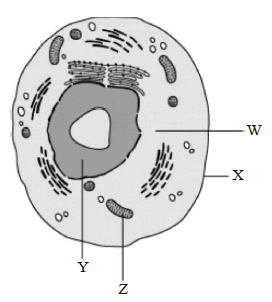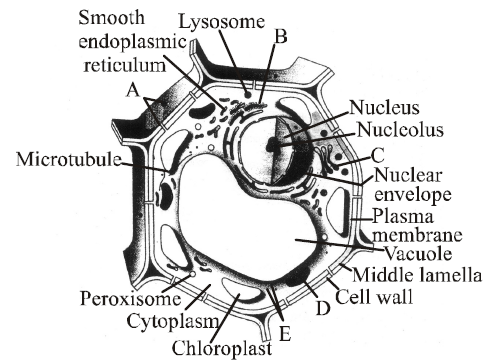A student placed two cells in the same solution in two different containers. The observation was given in the table.
| Container | Observation |
|---|---|
| 1 | Cell burst |
| 2 | Cell does not change its shape |
Which structure maintains the shape of the cell present in container 2 and provides the most significant difference between the two cells?
Nucleus
Cell wall
Chloroplast
Cell membrane
Correct Answer :
B. Cell wall
The cell wall protects the cell, maintains its shape and provides supports and strength to it. Nucleus controls the cell's activities. Chloroplast is a cell organelle that makes food for the plant cell. The cell membrane holds the parts of the cell together and also separates the cell from its surroundings.
Related Questions
Satellite means
terminal part of the chromosome beyond secondary constriction.
terminal part of the chromosome beyond primary constriction.
terminal part of chromosome beyond tertiary constriction.
none of the above
Match column-I (cell organelle) with column-II membrane and select the correct option from the codes given below.
| Column-I | Column-II |
|---|---|
| A. Mitochondria | I. Without membrane |
| B. Lysosomes | II. Single membrane |
| C. Ribosomes | III. Double membrane |
A - I, B - II, C - III
A - III, B - I, C - II
A - III, B - II, C - I
A - II, B - III, C - I
Microtubules are absent in
mitochondria
centriole
flagella
spindle fibres
Which of the following is incorrect ?
Mycoplasma is the smallest cell (0.3 �).
Bacteria are 3 to 5 �m in size.
The largest cell is the egg of an ostrich.
Nerve cells are some of the smallest cells.
Which of the following option correctly match A, B, C, and D indicated in the given sectional view of chloroplasts.

A - Thylakoid, B-Stromal lamella, C - Stroma, D - Granum
A - Granum, B - Thylakoid, C - Stromal lamella, D - Stroma
A - Thylakoid, B - Granum, C - Stromal lamella, D - Stroma
A - Granum, B - Thylakoid, C - Stroma, D - Stromal lamella
The lipid component of the membrane mainly consists of __________.
polysaccharides
phosphoglyceride
monosaccharaides
both (a) and (c)
Protein synthesis in an animal cell occurs
on ribosomes present in cytoplasm as well as in mitochondria.
on ribosomes present in the nucleolus as well as in cytoplasm.
only on ribosomes attached to the nuclears envelope and endoplasmic reticulum.
only on the ribosomes present in cytosol.
Golgi apparatus is concerned with
excretion
secretion
ATP synthesis
RNA synthesis
Prokaryotic and eukaryotic flagella differ in the
type of movement and placement.
location and mode of functioning.
microtubular structure and function.
microtubular organization and type of movement.
Microtubules, motor proteins, and actin filaments are all part of the
mechanism of photosynthesis that occurs in chloroplasts.
rough ER in prokaryotic cells.
cytoskeleton of eukaryotic cells.
process that moves small molecules across cell membranes.

Which function is carried out by the cell organelle 'X'?
helps control the movement of substance in and out of the cell
passes information from the parent cell to newly formed cell
maintains the proper shape of the cell and serves as a protective barrier
helps the cell to make food with the help of chlorophyll and sunlight
Which of the following statements are correct ?
- In prokaryotic cells, a special membranous structure formed by the extension of the plasma membrane into the cell is known as polysome.
- The smooth endoplasmic reticulum is the major site for synthesis of glycoproteins.
- RuBisCO is the most abundant protein in the whole biosphere.
- Mitochondria, chloroplasts and peroxisomes are not considered as part of endomembrane system. Of the above statements
(iii) and (iv)
(i) and (ii)
(ii) and (iii)
(i) and (iv)
9.A student was given cell samples (A and B) to identify parts which are highlighted. He observed the samples under the microscope and list down the function of the part of cell sample. The information collected by the student is listed in the table below, on the basis of which the student infers that the samples contain the organelles.
| Sample A | Sample B |
|---|---|
| Make energy available for cellular metabolism | Generates ATP and synthes izes s ugar |
| Absent in cell that carry oxygen throughout the body | Present in plant cell |
| Called the energy currency of cell | Source o f all the food energy |
Explain why the samples were belonged to eukaryotic cell and not prokaryotic cell? Because,
eukaryotic cell have membrane bound organelles.
eukaryotic cell have non - membrane bound organelles.
eukaryotic cell are smaller and multiply more rapidly than prokaryotic cells.
eukaryotic cell are larger and multiply more rapidly than prokaryotic cells.
The following diagram shows some of the missing structures in a plant cell marked as A, B, C, D E. Choose the option with their correct names.

A - Plasmodesmata, B - Rough endoplasmic reticulum, C - Golgi apparatus, D - Mitochondrion, E - Ribosomes
A - Desmosome, B - Rough endoplasmic reticulum, C - Golgi apparatus, D - Mitochondrion, E - Ribosomes
A - Plasmodesmata, B - Smooth endoplasmic reticulum, C - Golgi apparatus, D - Mitochondrion, E - Ribosomes
A - Tight junction, B - Rough endoplasmic reticulum, C - Golgi apparatus, D - Mitochondrion, E -Ribosomes
Active transport differs from passive transport in that active transport
requires energy.
always requires input of ATP.
moves molecules against a concentration gradient.
both (a) and (c)
Match column I (cell type) with column II (size) and choose the correct option.
| Column-I | Column-II |
|---|---|
| (Cell type) | (Size) |
| A. Viruses | I. 1-2 ??m |
| B. PPLO | II. 10-20 ??m |
| C. Eukaryotic cell | III. About 0.1 ??m |
| D. Bacterium | IV. 0.02 - 0.2 ??m |
A I, B II, C III, D IV
A IV, B III, C II, D I
A I, B III, C II, D IV
A IV, B II, C III, D I
You are asked to examine a cell using a powerful light microscope. The image you see has a clearly defined nucleus and mitochondria. It also has a large central vacuole and chloroplasts. From what group of organisms did this cell most likely come?
Bacteria
Protists
Fungi
Plants
The given diagram shows the sectional view of a mitochondrion.

Identify the parts labelled as A, B, C, D & E
A - Outer membrane, B - Inner membrane, C - Matrix, D - Inter- membrane space, E - Crista
A - Outer membrane, B - Inner membrane, C - Intermembrane space, D - Matrix, E - Crista
A - Outer membrane, B - Inner membrane, C - Matrix, D - Crista, E - Inter - membrane space
A - Outer membrane, B - Inner membrane, C- Crista, D - Matrix, E - Inter-membrane space
Which of these is wrongly matched?
Chloroplasts Chlorophyll
Elaioplasts Starch
Chromoplasts Carotenoids
Amyloplasts Carbohydrates
Which of the following statements is/are correct ?
- The endomembrane system includes plasma membrane, ER, Golgi complex, lysosomes and vacuoles.
- ER helps in the transport of substances, synthesis of proteins, lipoproteins and glycogen.
- Ribosomes are involved in protein synthesis.
- Mitochondria help in oxidative phosphorylation and generation of ATP.
(ii), (iii) & (iv)
(i) only
(ii) only
(iii) only
The given figures show two types of cell. Which structures are common to both the cells?

Nucleus and cell wall
Nucleus and cytoplasm
Ribosomes and flagella
Ribosomes and cell wall
Extension of plasma membrane in prokaryotic cell is
mesosome
haploid
ribosome
none of these
Which of the following organelles is directly connected to the outer membrane of the nucleus in a eukaryotic cell?
Mitochondrion
Lysosome
Golgi apparatus
Endoplasmic reticulum
The figure below shows the structure of a mitochondrion with its four parts labelled (A), (B), (C) and (D).

Select the part correctly matched with its function.
Part (D): Outer membrane Gives rise to inner membrane by splitting.
Part (B): Inner membrane Forms infoldings called cristae.
Part (C): Cristae Possess single circular DNA molecule and ribosomes.
Part (A): Matrix Major site for respiratory chain enzymes.
Integral proteins of cell membrane occur on/in
inner surfaces
outer surfaces
phospholipid matrix
inner and outer surfaces
Difference between the prokaryotic and eukaryotic cells in having
cell wall
nuclear membrane
ribosome
none of these
Which of the following statement is false?
The ribosomes of a polysome translate the mRNA into protein.
Mitochondria divide by fragmentation.
All cell arise from pre-existing cells.
The lipid component of the membrane mainly consists of phosphoglycerides.
Lysosomes contain
carbohydrates
hormones
nucleic acids
hydrolases.
A component of cytoskeleton is
microtubule
bone
chitin
cartilage.
Nucleolus is
rounded structure found in cytoplasm near nucleus.
rounded structure inside nucleus and having rRNA.
rod-shaped structure in cytoplasm near the nucleus.
none of the above.
